Illustrated Review: Breaking down Nikita Kucherov's scoring binge

The 2016-17 Tampa Bay Lightning were handicapped as a favorite to make it out of the Eastern Conference, and probably for good reason.
Last season, the Lightning pushed the Pittsburgh Penguins to seven games in the Eastern Conference Final, holding leads of 1-0 and 3-2 in an incredibly tight series before losing in Game 7.
And then during the off-season, the Bolts re-signed forward Steven Stamkos and defenseman Victor Hedman before free agency opened, the only major questions facing Tampa Bay's summer (though the latter had a year remaining on his previous deal).
Taking those two cornerstone players combined with the likes of defenseman Anton Stralman, young forwards Tyler Johnson, Nikita Kucherov, Jonathan Drouin, and Ondrej Palat, and the goaltending tandem of Ben Bishop and Andrei Vasilevskiy, and optimism was, at the bare minimum, logical.
Illustrated Review: Maple Leafs’ power play reinvigorated by shot volume, new talent
But fast-forward to mid-November, and Stamkos is sidelined by a knee injury that and has not played since. Forward Ryan Callahan had his season cut short due to hip surgery, and the Lightning have been fighting through injuries and performances not up to their own standard for large swaths of the season.
Even with the depth Tampa Bay has, the loss of Stamkos is no easy hurdle to overcome, and on Jan. 26, the Lightning found themselves tied for the fewest points in the East. Tampa Bay was trending in the wrong direction, still five points back of eighth-place Philadelphia at the time, but a different outlook than about 10 weeks earlier, when Stamkos was injured, and Tampa was a top-four team in the East.
During that slide, the Lightning's offense showed a lot less charge. In the 17 games played with Stamkos prior to him being placed on injured-reserve, the Lightning averaged 3.12 goals per-game; in the next 32 games post-Stamkos, when Tampa slowly saw teams creep by in the right lane, the Lightning averaged 2.5 goals per game.
In need of an offensive spark, and one that could salvage its season and playoff hopes, the Lightning got that boost internally in what has been the league’s most productive offensive run over the past two months: Kucherov.
Since Jan. 26, Kucherov leads the NHL in goals (20) and points (37). The diminutive left-shot forward formerly of Triplets line fame has gone the route of Beyonce, striking a debut album with two associates but now making his biggest impact as a solo artist.
Kucherov has dwarfed his previous career-highs this season, surpassing personal bests in goals (38 from 30), assists (42 from 36), and points (80 from 66). His goal scoring of late has been roaring, 0.77 per game since that Jan. 26 split.
And if head coach Jon Cooper called for his group to step up and produce more offense, Kucherov has certainly picked up on the other line, though the underlying numbers show he's doing much of the same.
Illustrated Review: Breaking down the options on the Bruins' top line wing
Over this 26 game run, Kucherov has registered 101 shots on goal, or 3.88 per game. Through his first 42 games, Kucherov had taken 132 shots, or 3.14 per game. So he's finding the net more.
But in terms of his attempts and his even-strength shots on goal, Kucherov hasn't seen any increase.
While Kucherov has attempted and taken fewer shots on goal at even-strength over his torrid stretch, his scoring chances have gone up. And this reveals a few things: Kucherov has seen a boon on the power play—11 goals in his past 22 games versus seven in his first 42—and that what he's doing isn't some unsustainable anomaly, to an extent.
Kucherov's scoring pace, a 63-goal stroke-rate over his past 26 games extrapolated over a full season, is gaudy. But then there are other things about the splits—a 13.58 5v5 shooting percentage in his first 42 games versus 10.42 over his past 26—that seem less fluky. He's playing a minute more at 5-on-5 per game over his past 26, but that's not a usage spike that would regulate his scoring in and of itself.
The one area that raises an eyebrow is the power play, where Kucherov has literally doubled his shooting percentage from 12.5 to 25. It's likely he falls somewhere between those two numbers, but that he's literally scoring twice as often as he previously was on the power play has been a major boost to his numbers.
Buoying the goal total is an increase in shots: Kucherov has taken 25.8 on-goal per 60 minutes in his past 26 games on the power play compared that 17.9 over his first 42.
Tampa Bay is no stranger to watching an individual dominate on the power play, but to say it's as simple for swapping in Kucherov for Stamkos is a bit thin. Even to keep things exactly the same from a schematics standpoint, Kucherov, a left-hand shot, would have to have a mirrored playbook for that of Stamkos (right-handed).
A deeper look at the Tampa Bay Lightning struggles
The Senator of the Right Circle
Recall Feb. 27 when Kucherov scored a power-play hat trick against the Ottawa Senators, the goals all nearly identical.
What this 14:09 stretch illuminated besides where Kucherov is most effectives—shooting pucks off the right faceoff dot—is how Tampa Bay gets him the puck.
Whenever Alex Ovechkin scores from His Office, everyone wonders how he gets so open. The same can be said of any shooter, like Stamkos. The answer is by diversifying the delivery, disguising the punch line with a different build-up and an altered cadence.
What Tampa Bay does so well here to free Kucherov up is let the puck do the work. He and Palat quickly interchange spots along the right side, and, by doing so, Kucherov not only touches the puck, but Palat provides natural interference and skates right through the Ottawa defense.
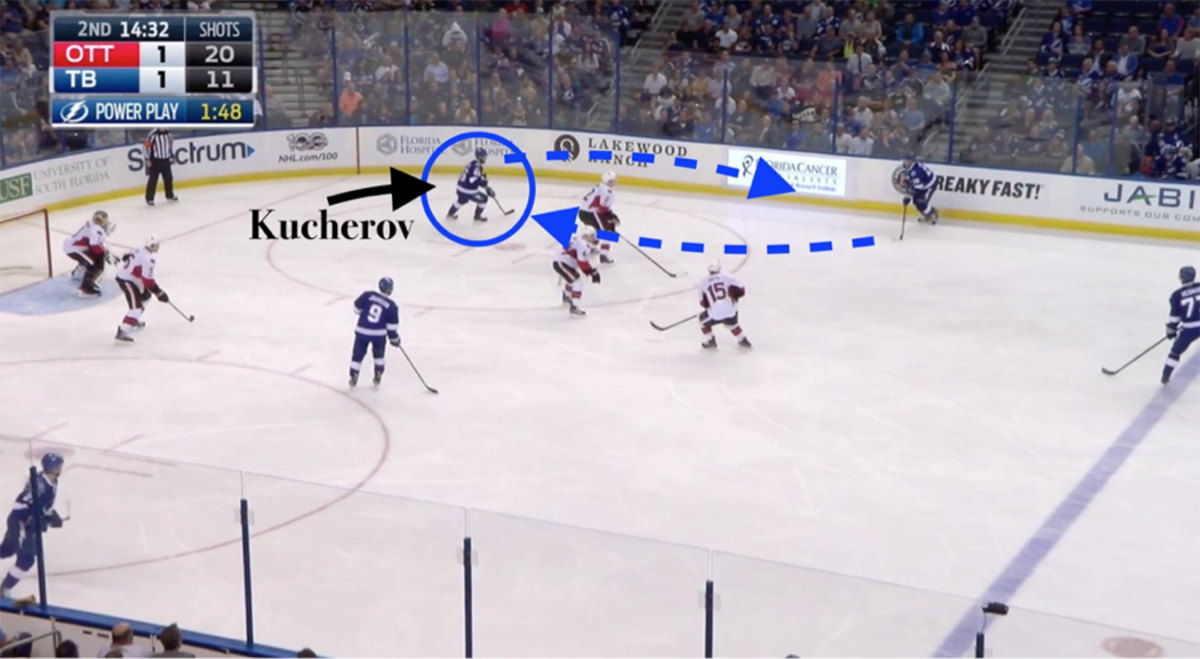
This next exchange is so important. Tampa works this quick triangle—Kucherov to Hedman to Kucherov, across to Drouin and Ottawa is officially in full chase. It's both vertical and horizontal, changing levels by going up to Hedman at the blue line, then sides with a cross-ice feed to Drouin.
Now Drouin has some space to skate into, which he has to do. By taking the puck toward the goal, he drags everyone to the left side of the ice. Kucherov is now all alone on the other side of the frame, but getting the puck there will require two passes. First, Drouin drops a pass to Hedman, who this time, is able to condense the offensive zone by how far Ottawa has been stretched.
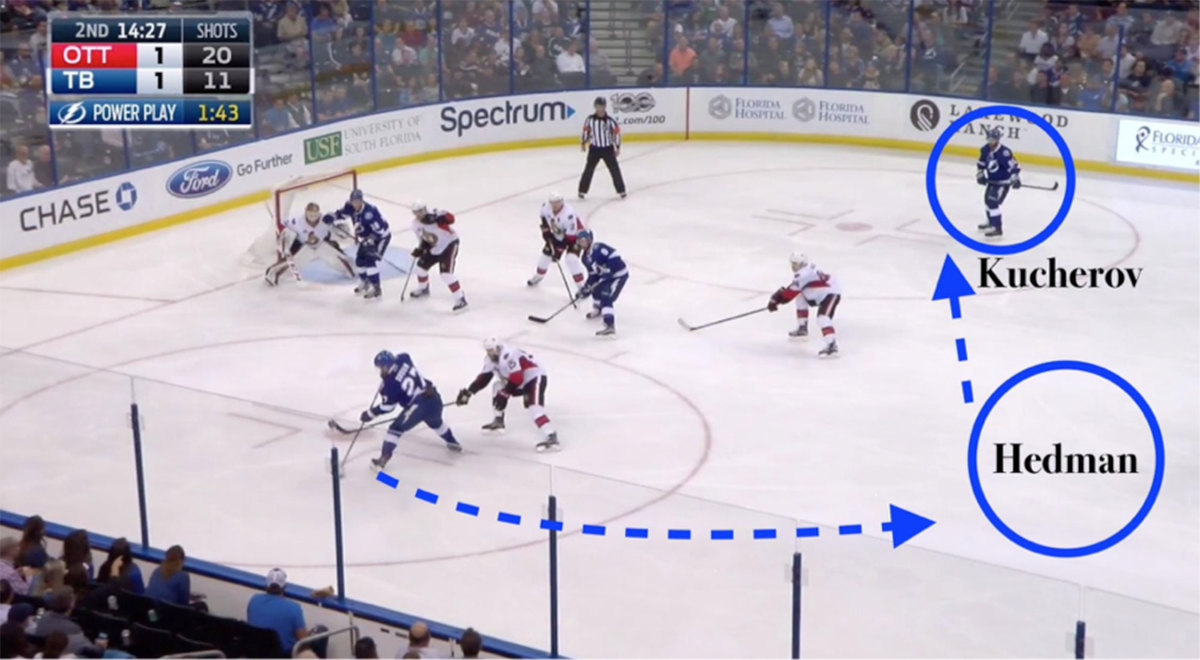
And on the reverse angle, you can see what Hedman has in front of him by the time he regains possession. Ottawa is completely shaded to the left side of the zone, leaving Kucherov in a shooting position on his strong side.
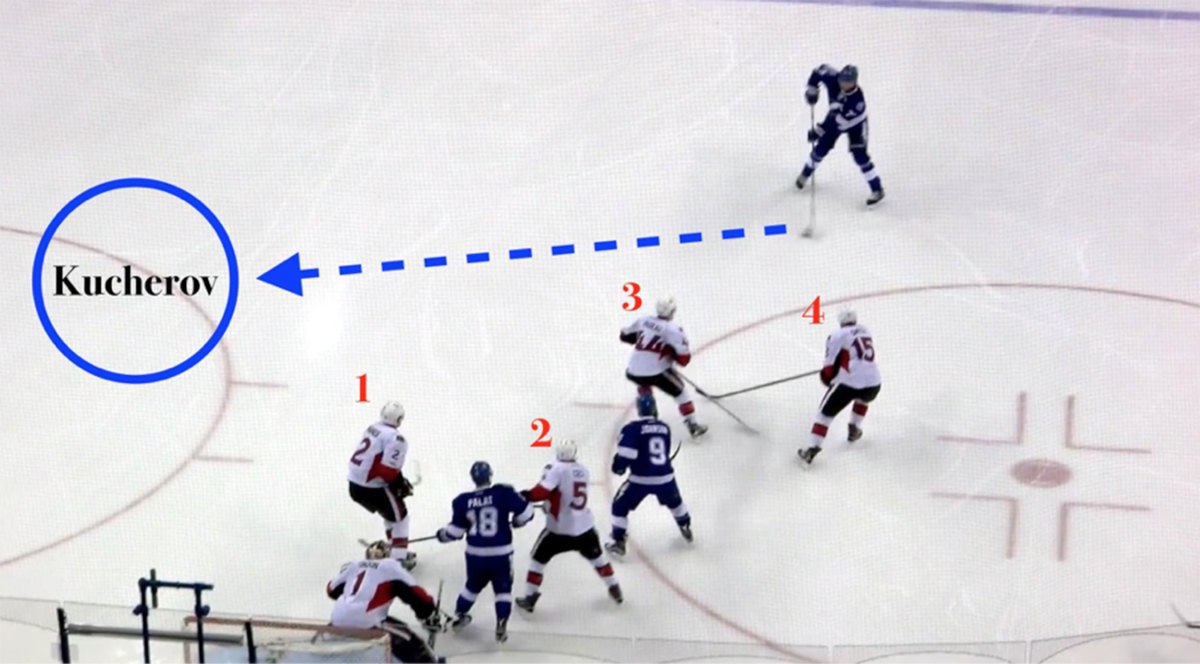
This all happened off a zone entry. But on Kucherov's second power-play goal, Tampa Bay wins a faceoff and then gets Kucherov the puck in space.
First is the basic setup. Johnson takes the faceoff, with Kucherov to his right, and Palat on the left. There's a scramble after the puck is dropped, and Palat and Kucherov both pinch in. Eventually, Palat is able to bat the puck across to Drouin.
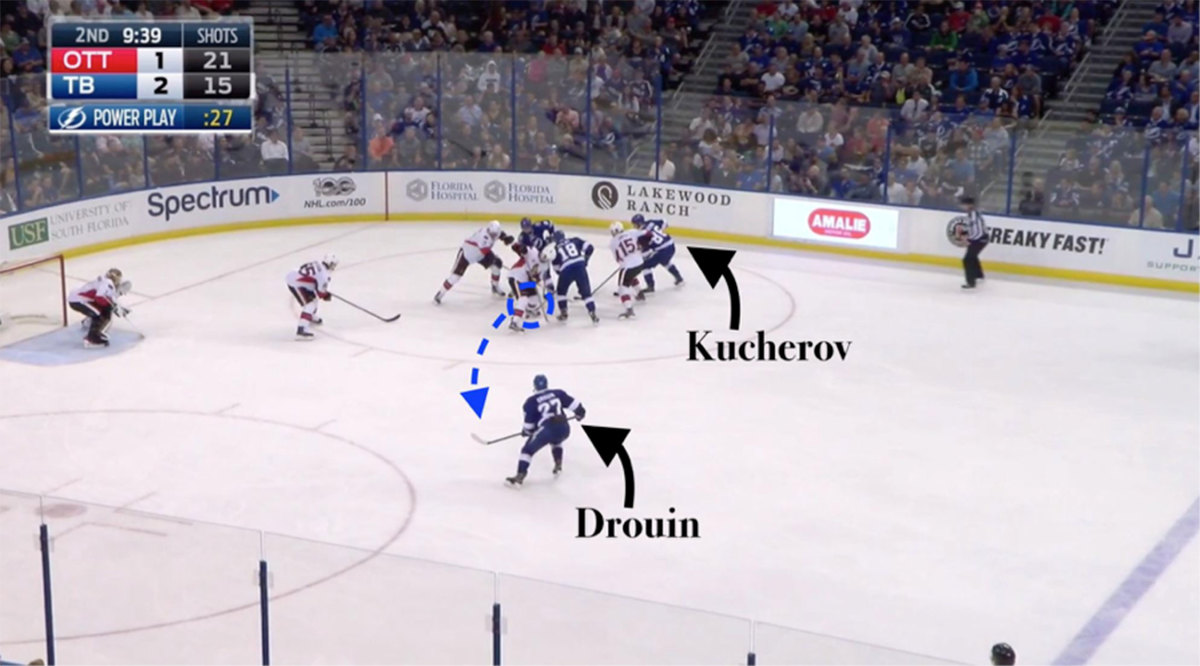
There's a concept in basketball where, off an inbounds pass, the player taking out the ball is actually the shooter. Though Kucherov isn't taking this faceoff, the spacial concept to this play is analogous: Get possession, move around, and disguise that possession is going back where it came from.
Drouin corrals the puck and curls toward the blue line. By doing this, he's drawing Ottawa away from the faceoff circle, leaving Kucherov (the pseudo-inbounder) all alone.
And by doing so, Drouin forces the hand of both Senators forwards and Marc Methot, the closest defender, is caught in no-man's land.
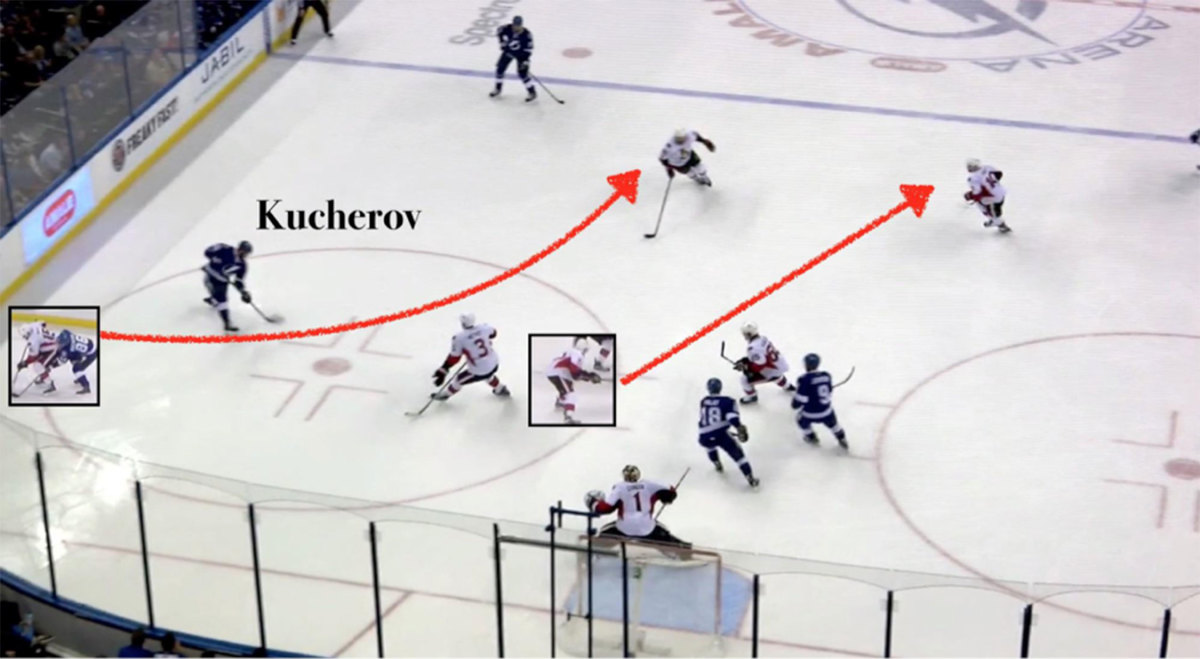
On his hat trick goal, Kucherov had an initial shot blocked only to score seconds later with a slightly tweaked delivery.
Tampa Bay enters the zone, dumps the puck down the boards, and then reverses it, getting it to Drouin, and how this sequence begins. The Bolts are relieving pressure valves by going from side-to-side, so there's enough of a gap they can actually breathe.
But when Hedman moves the puck to Drouin, Ottawa is still tightly packed. The Sens can rotate over to Kucherov and make a defensive play, especially because Kucherov is unable to one-time the puck.
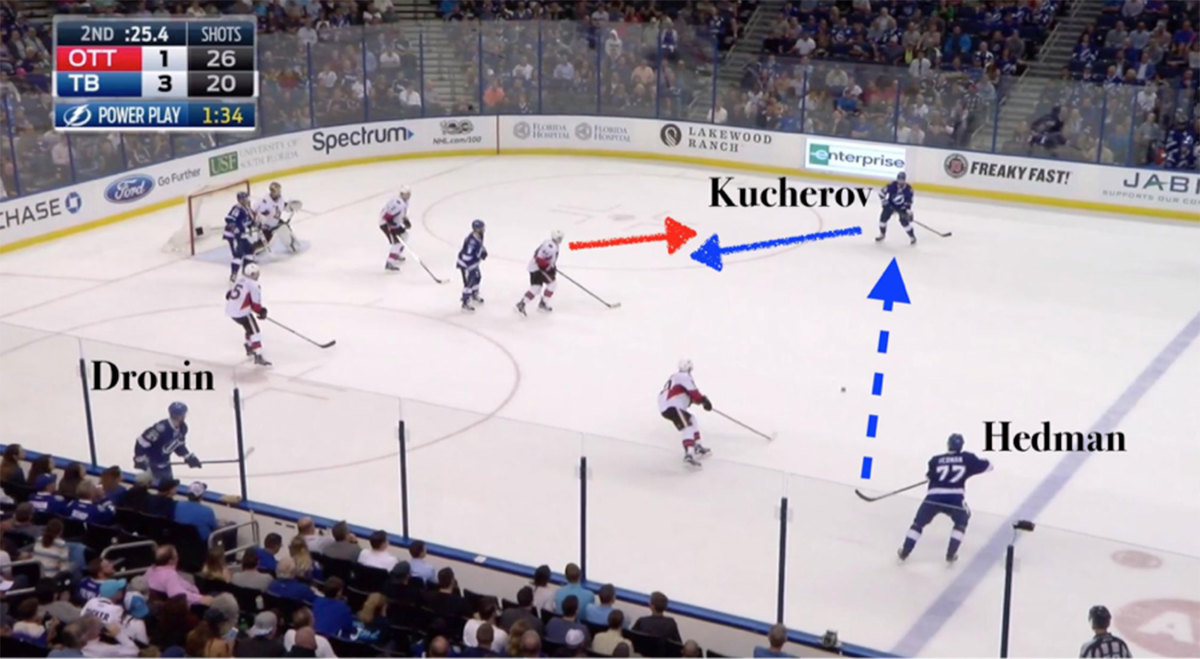
The puck gets swatted around but eventually ends up on Drouin's stick, and now the dynamic of the play is very similar to what Tampa Bay did off the face-off. The goal is to get the puck back to Kucherov, where it just came from. Possession just changed sides, so now the penalty killers have to rotate. But Drouin doesn't just wait for them to check him; he skates toward the goal, distending the penalty killers even more.
So this time when Hedman gets the puck, Ottawa is all out of sorts: Cody Ceci is peeling out of the corner having played Drouin, Tom Pyatt is pressing the point to attack Hedman, and Jean-Gabriel Pageau is on Johnson's hip, another key element to this play. By occupying the bumper spot, Johnson forces Ottawa from cheating toward a circle.
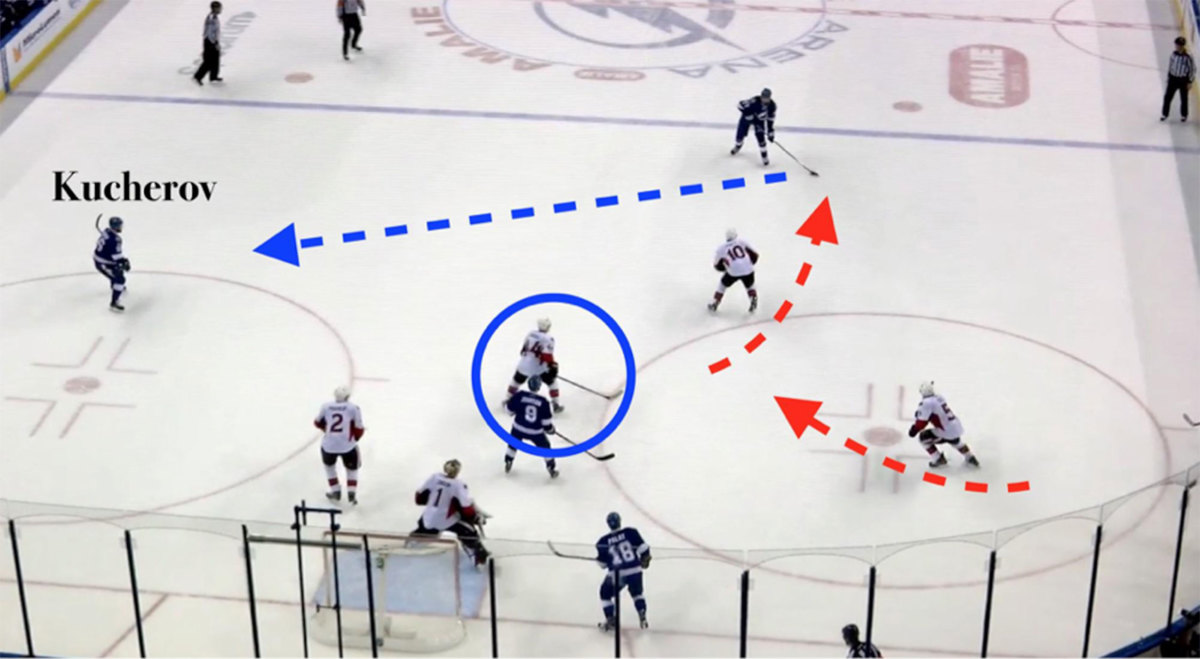
When preparing to play against the Lightning, it will be on the video or the white board of any special teams meeting: 86, left-hand shot, right circle, etc. This is a strength of Kucherov's, one that has seen him skyrocket up the goal-scoring leaders over 25 percent of the schedule.
But during the run of play, with Tampa Bay camouflaging its true intentions with dummy movements and passes, things don't always go to plan.
But for the Lightning, the plan has become simple: Get Kucherov the puck, and let him do the rest.
